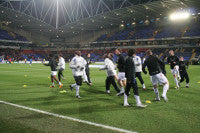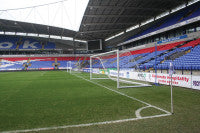Warming up without heating up!
Warm up guidelines, championed by Pitchcare, and adopted by the Premiership and Football League, are designed to reduce the impact of pre and post match activity on the playing surface.
Clearly, this is a big step forward, but much still needs to be done to protect the groundstaff from ranting coaches and dribbling players!
 One of the most contentious pitch issues regularly facing professional football groundsmen is the intensity of warm ups and warm downs before and after games. The damage done can be quite excessive, for example, fast feet and shooting drills can cause concentrated damage to small areas and goalmouths.
One of the most contentious pitch issues regularly facing professional football groundsmen is the intensity of warm ups and warm downs before and after games. The damage done can be quite excessive, for example, fast feet and shooting drills can cause concentrated damage to small areas and goalmouths.
I received a call from one concerned head groundsman, who had had a confrontation with an away team's goalkeeping coach about the length of time and intensity of the warm up in one of his goalmouths.
The away team coach had blatantly ignored the League Football guidelines on warm ups, even though a notice was posted in the changing rooms for all to see. He further chose to ignore the head groundsman's requests ,and blatantly allowed his players to practise shooting in one of the main goalmouths and not the portable goals provided.
I contacted a number of leading groundmen who conceded that warm ups/downs did cause them a lot of anxiety, especially during the winter months when grass recovery is  poor and air and soil temperatures are low.
poor and air and soil temperatures are low.
Most stadiums have shade problems to one degree or another and, often, soil and air temperatures in these areas can be between 5-10 degrees lower than the rest of the pitch. Even though groundstaff indicate where players should warm up, with the aim of rotating usage and keeping out of shaded areas, their requests are often ignored.
Many grounds are restricted in the size of their pitch surrounds. This means that fast feet drills take place on the pitch itself, and not along the touch line.
The head groundsmen I spoke to said that, depending on who the visiting team was, there were various levels of cooperation but, in some cases complete non cooperation (the polite version!).
Here are few comments from Pitchcare members:
"Without question, the pitch I maintain would have 'September' condition all winter if we eliminated pre and post match activity. I go to extreme lengths to manage these activities so as little damage as possible occurs. It is 100% accurate to state that pre and post match exercises cause more damage than a full game."
One said; "On the one hand, we are providing the facility for it to be used to the maximum benefit of the players and spectators whilst, on the other hand, the coaching staff are happy to trash it. They have to be aware this abuse is to the detriment of all later in the season."
"Essentially, there is no such thing as a warm down anymore," said another. "What it has become is a 30-40 minute training session for unused subs. The eleven starters have a jog and chat - commonly known as warm down. The six or so subs from both sides go hell for leather, fast feet etc. We even have a sub keeper warm down now with a ball!"
Another said; "I absolutely agree, warm ups and downs are a nightmare, and usually do more damage than the actual match."
And, finally: "Try having a dual purpose pitch like mine. I'm the only groundsman at a club with rugby union and football at a high level - forty four (at least!) rugby players doing intensive cone to cone drills, and running through plays; line out practice in one place for several minutes - which never happens in a match; the day before the match, full team run and kicking practice - bad weather never stops this, ever. Also, after match huddles, all bandaging - which is sweaty and often bloodstained - is discarded on to pitch. Disgusting and totally unnecessary."

I also spoke to Alan Ferguson, Head Groundsman at Ipswich Town FC, who had, in November, been talking to the Football League about this sensitive subject.
Alan is only too aware of the problems, and believes the only way to solve it is to educate and improve the communication between coaches and groundstaff. "Nothing has upset groundsmen more in recent seasons than team's warm ups and warm downs. Like many other areas of the game, the player's pre match activity has been taken to new levels. Speak to any of the fitness coaches, or sports scientists as they prefer to be called these days, and they will talk to you about the need to lift all levels of the body activity ahead of the game."
"This step up has seen warm ups become explosive in there execution, with much of the work focused on speed and agility," say Alan. "This, in turn, has seen the volume of pre-match damage on the pitches increase. Even on a good day, and on the best pitches, some of this damage remains visible once the game starts, despite the groundstaff's furious efforts to repair it all in the final minutes ahead of kick off."
So, how do groundsmen tackle the problem? The post match incident between the Chelsea groundstaff and some Manchester United players a couple of seasons ago certainly brought the issue into the public domain. The publicity that followed did neither players nor groundstaff any favours.

Warm up guidelines, have been adopted by both the Premier and Football Leagues. They have certainly helped to define what can and cannot be done. Whilst they remain guidelines in the Premiership, they are now regulations in the Football League. Yet, despite this step forward, some groundsmen still have problems with certain coaches.
"From my own personal experience at Ipswich, these problems are becoming fewer," says Alan. "I am finding, by using the guidelines as an aid, and by meeting the visiting staff when they arrive at the ground, I can have a discussion with them as to what they prefer to do. I then put my case of where I would prefer that activity to take place, Then, somewhere in between, we arrive at a solution that suits fitness coach and groundsman. Any relationship has to be worked at, even if it is only going to last a matter of hours."
The Football League's Playing Surfaces Committee continue to monitor the situation regarding warm ups and warm downs, but I would urge groundsmen to get more involved and help to make them work.
The Football League guidelines state:
29. Pitch Protection
29.1 In order to protect the pitch, unless otherwise mutually agreed between both participating clubs, the following procedures shall be adopted by players and officials in the periods immediately before and after a match and at half time:
(a) the pitch shall not be used by players for warming up until 45 minutes before the kick-off time;

(b) warming up by either team shall not last for more than 30 minutes;
(c) if portable goals are provided they shall be used for all goalkeeping drills other than crossing practice;
(d) the goalmouth area shall be used by goalkeepers only if portable goals are not provided or for crossing practice and then only for not more than 20 minutes;
(e) for the purposes of warming up each team shall use only part of the pitch between the edge of a penalty area and the half way line or as otherwise directed by the groundsman;
(f) all speed and stamina work shall be undertaken off the pitch parallel to the touchline opposite the side to be patrolled by the assistant referee or, in the absence of sufficient space, in that part of the pitch described in paragraph (e) above or as otherwise directed by the groundsman;
(g) only substitute players who have then not played in the match may warm up at half time when the requirements of paragraphs (e) and (f) shall apply and substitute goalkeepers shall use the goalmouth areas only for crossing practice;
(h) substitute players using the pitch at half time as aforesaid shall give due consideration to any other activity or entertainment taking place on the pitch at the same time;
(i) the home club may water the pitch at half time provided that it gives reasonable notice to the referee and the other club that it intends to do so and that any such watering is carried out evenly over the entire length and width of the pitch;
(j) any warming down after the conclusion of the match shall last for no longer than 15 minutes and for that purpose neither penalty area shall be used.
The demands on the groundstaff to keep pitches playable and presentable, especially during the winter months, are considerable. Groundstaff are fully aware of their responsibilities and understand that there needs to be warm up practices, But, it really is a case of working with visiting teams to reduce the wear factor during the winter months.
We need to educate the clubs, physios, coaches and managers about the consequences of their actions. They need to understand the important role that the groundstaff play at a football club. Only by working together, will we alleviate the problem of wear from warm ups and warm downs.
With the clubs' playing staff having a better understanding of the issues facing their groundsmen maybe, just maybe, they will respect the job they do for them.
There will always be some coaching staff who will ignore the groundsman's wishes, and the League regulations, and continue to do whatever they want to do. Maybe the regulations should go a lot further, and penalise errant coaches?
